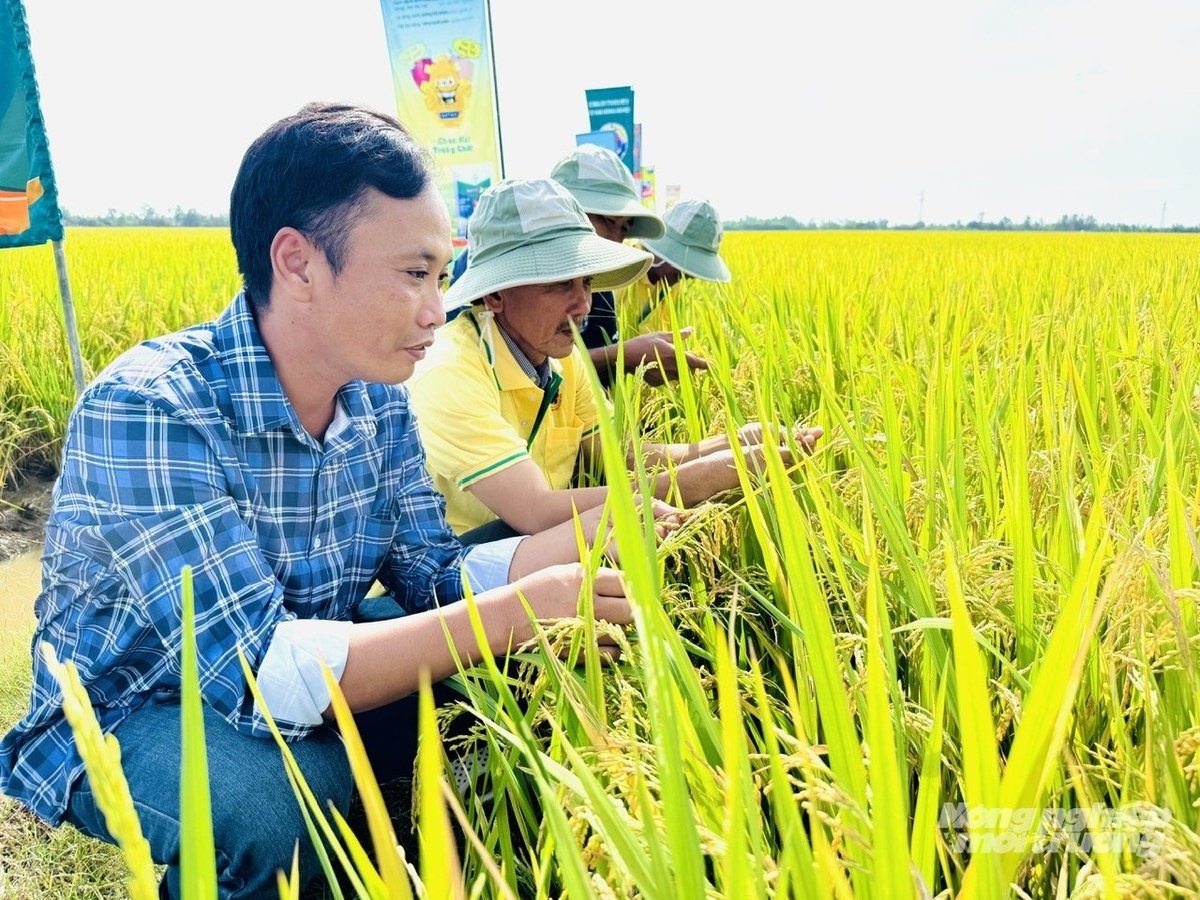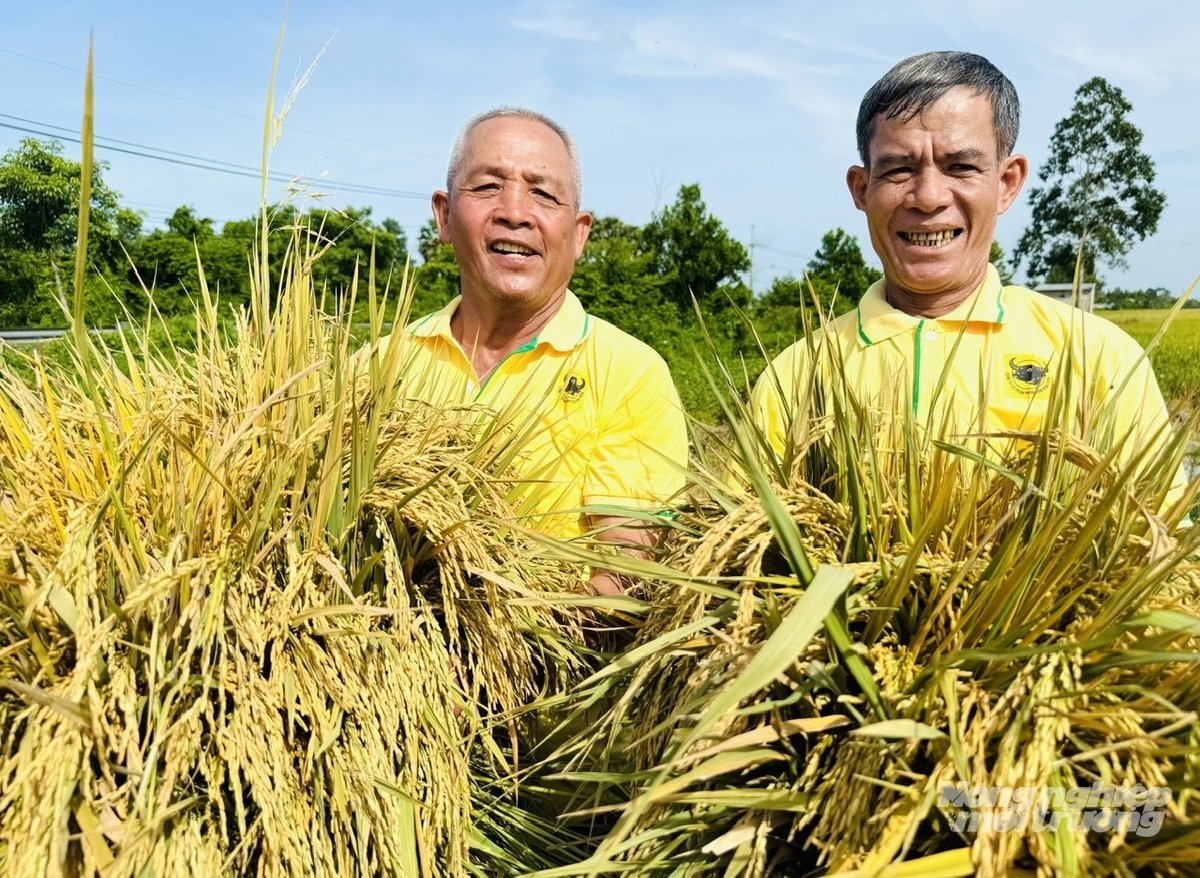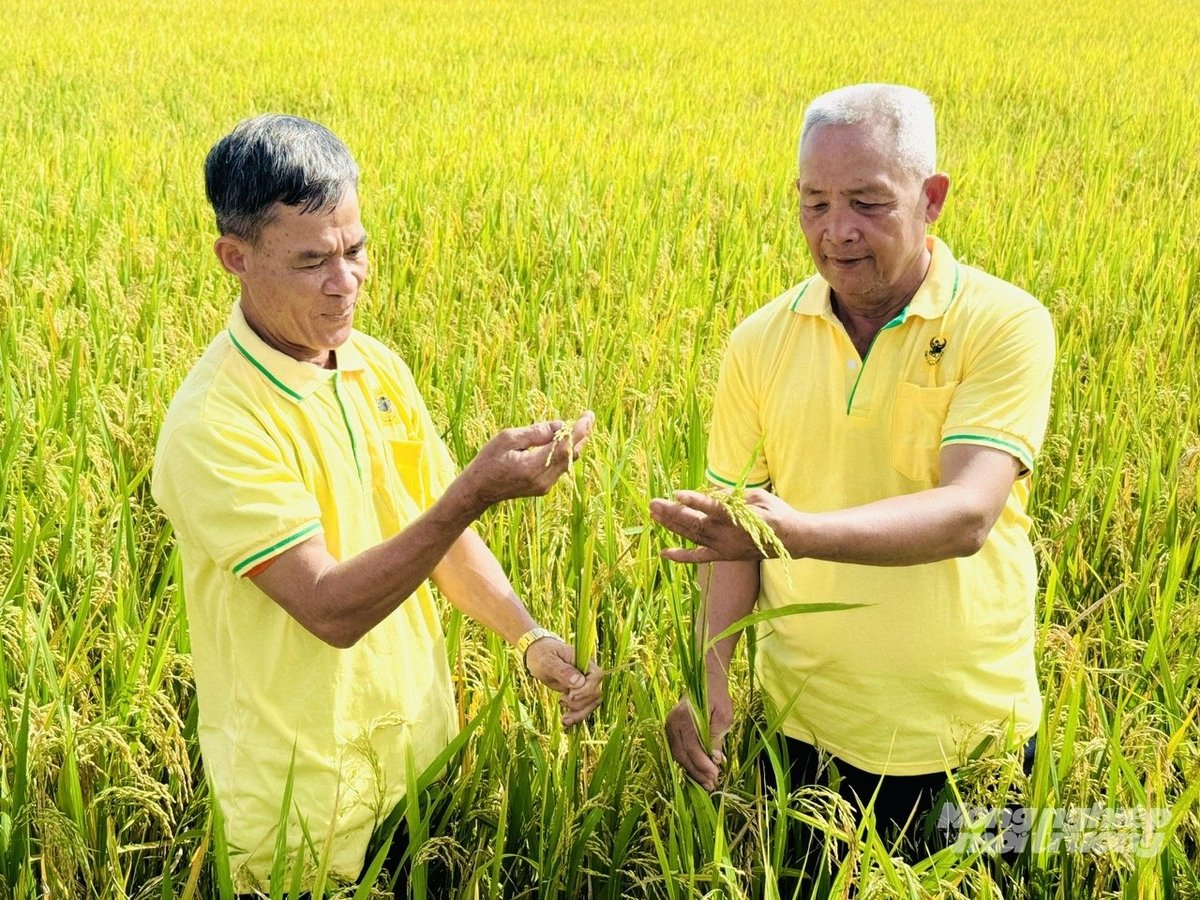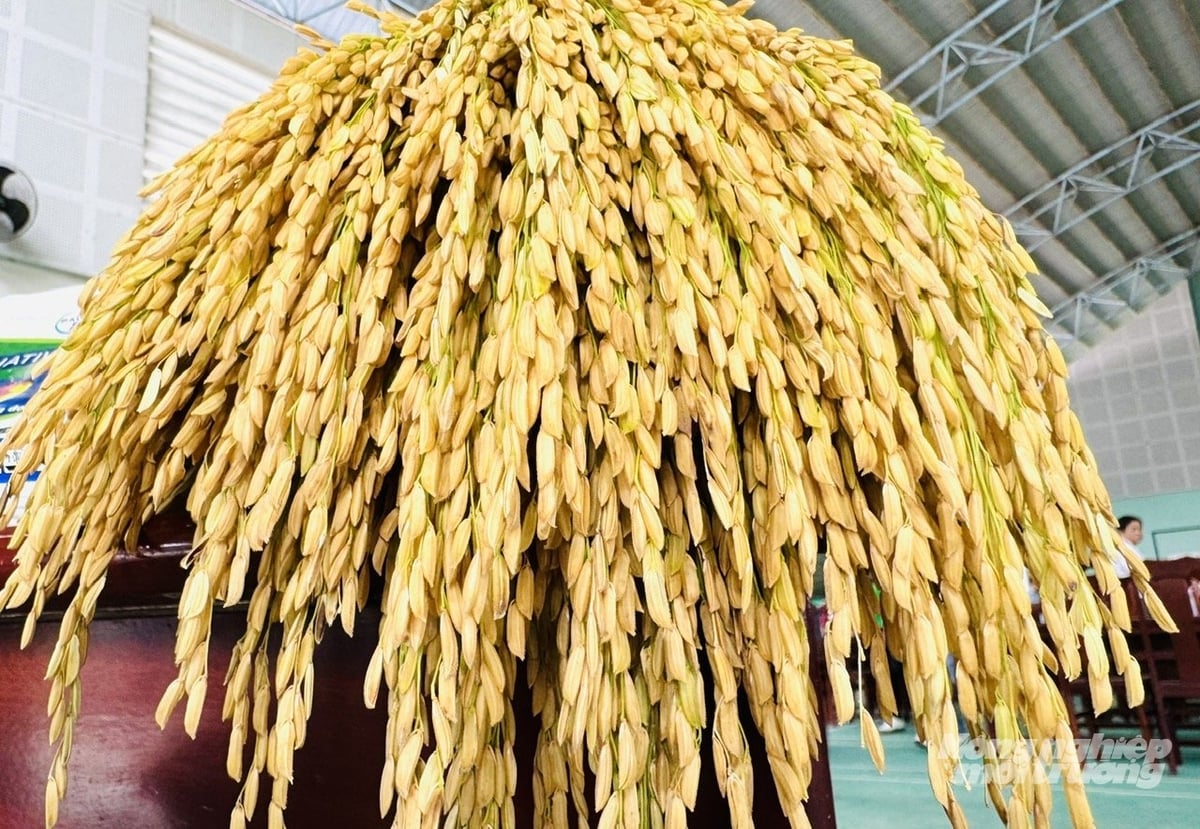December 6, 2025 | 00:28 GMT +7
December 6, 2025 | 00:28 GMT +7
Hotline: 0913.378.918
December 6, 2025 | 00:28 GMT +7
Hotline: 0913.378.918
The An Giang Provincial Agricultural Extension Center has recently organized a conference to review the central agricultural extension project “Developing a low-emission rice farming model for the sustainable development of export-oriented rice production areas in the Mekong Delta” during the 2025 summer–autumn rice crop in Thanh Hoa Commune, An Giang Province. The event brought together representatives of agricultural cooperatives and more than 200 farmers from both within and outside the model area to observe and exchange experiences.

Farmers in Dinh Hoa Commune (An Giang) visit a demonstration field of the high-quality, low-emission rice model implemented by the provincial Agricultural Extension Center in cooperation with Thanh Xuan Agricultural Cooperative during the 2025 summer–autumn crop. Photo: Le Hoang Vu.
This program is led by Binh Dien Fertilizer Joint Stock Company and implemented in Mekong Delta provinces such as An Giang, Can Tho, and Dong Thap.
At Thanh Xuan Agricultural Service Cooperative (Hoa Xuan Hamlet, Dinh Hoa Commune, An Giang Province), the high-quality, low-emission rice production model under the One Million Hectares of High-Quality Rice Project has initially recorded encouraging results in the 2025 summer–autumn crop.
According to Mr. Le Van Dung, Deputy Director of the An Giang Provincial Agricultural Extension Center, the pilot model covers 50 hectares, involving 11 households out of the cooperative’s 132 members, with a total production area of 300 hectares. Several partners, including the National Agricultural Extension Center, the An Giang Agricultural Extension Center, Binh Dien Fertilizer Joint Stock Company, Vinarice, Bayer Vietnam, Sai Gon Kim Hong, and Phan Tan, have joined forces with the cooperative to implement the model. The dual objective is to enhance economic efficiency and reduce greenhouse gas emissions in rice production.
The farming process is designed with modern practices, applying a synchronized set of advanced techniques such as cluster sowing combined with fertilizer incorporation, alternate wetting and drying (AWD) irrigation, straw collection, and the use of specialized microbial and organic fertilizers.
Compared with traditional practices, the model saves 41.6% in seed usage, significantly reduces fertilizer and pesticide costs (cutting two spraying cycles per crop), and saves about 30–40% of irrigation water. Total rice production costs in the model are reduced by VND 1.42 million per hectare, while yields increase by 0.31 tons per hectare, raising average profits by nearly VND 3.9 million per hectare - over 20% higher than outside the model. The production cost per kilogram of rice is also reduced by VND 396, giving the product a stronger competitive edge in the market.

Members of Thanh Xuan Agricultural Cooperative are delighted with rice farming practices that help reduce greenhouse gas emissions. Photo: Le Hoang Vu.
Notably, the model has proven highly effective in reducing greenhouse gas emissions, an important factor in the global shift toward carbon-neutral agriculture. Total emissions within the model were only 1,114 tons of CO2, a reduction of nearly 1,189 tons compared to baseline emissions, equivalent to a 48.38% decrease. Specifically, CH4 emissions from rice fields were reduced by 12,370 kg, equivalent to about 334 tons of CO2, thanks to strict compliance with AWD water management techniques and proper straw management in the field.
According to Mr. Tran Tan Xuyen, Director of Thanh Xuan Agricultural Cooperative, participation in the model has brought many positive changes for farmers. Compared with traditional farming practices, it helps farmers cut costs, reduce the use of fertilizers and pesticides, and better control pests and diseases while maintaining or even improving yields. More importantly, farmers gain access to advanced, environmentally friendly cultivation methods, moving toward sustainable and modern agriculture.
Mr. Xuyen noted that initially, some households were hesitant to reduce seed rates to just 70 kg/ha. However, after seeing real results, such as healthy crop growth, lower costs, and fewer pest problems, members have become more proactive in adopting new techniques. The cooperative is now working to expand the model across its entire production area and encouraging members to keep field logs, manage straw and water efficiently, and strengthen linkages for product consumption.

Farmers participating in the model apply a full range of advanced techniques such as cluster sowing combined with fertilizer incorporation, alternate wetting and drying irrigation, straw collection, and the use of specialized microbial and organic fertilizers. Photo: Le Hoang Vu.
According to Mr. Ho The Huy, Deputy Marketing Director of Binh Dien Fertilizer Joint Stock Company, in recent rice crops in the Mekong Delta, the company has consistently worked alongside farmers in the western provinces to implement high-quality, low-emission rice farming projects under the One Million Hectare Rice Project in the region.
For the model at Thanh Xuan Agricultural Cooperative, yields have far exceeded the project’s initial targets. Farmers have effectively adopted sustainable, low-emission rice cultivation practices, thereby reducing seed, fertilizer, and pesticide use while increasing both yields and profits - most notably cutting emissions by over 6 tons of CO₂ per hectare.
“We truly hope this model will be expanded in upcoming crops, thereby helping improve economic efficiency, raise incomes, and contribute to the successful implementation of the One Million Hecta Rice Project in the Mekong Delta,” Mr. Huy said.
According to Mr. Nguyen Truong Vuong, Director of External Affairs for the Crop Science Division at Bayer Vietnam, in the high-quality, low-emission rice production system in the Mekong Delta, proper use of pesticides plays a key role in meeting export standards. Rice quality is determined not only by good varieties, rates of broken and whole grains, pest and disease incidence, and the proportion of weed seeds in the final product, but also by appearance, color, and the effective management of chemical residues in the finished rice.

Rice grown under the low-emission farming model is largely free from pests and diseases, with a bright golden color and high quality. Photo: Le Hoang Vu.
Bayer has been carrying out training activities and promoting its “Much More Rice” solutions, focusing on the effective, safe, responsible, and sustainable use of pesticides, using the right product, at the right time, and only when truly necessary. This approach enables farmers to manage pests effectively while reducing the number of spraying cycles, thereby keeping residue levels within safe limits.
In practice, models implemented in the Mekong Delta provinces of An Giang, Hau Giang, Can Tho, and Dong Thap have shown that harvested rice, tested by the international organization Eurofins, meets the residue requirements of demanding markets such as the EU and the United States.
Mr. Tran Thanh Hiep, Deputy Director of the Department of Agriculture and Environment of An Giang Province, said that the province has registered 144,000 hectares under the One Million Hectares of Rice Project. With this area, An Giang has essentially met the targets set for 2025.
However, Mr. Hiep frankly acknowledged that many challenges remain. Certain targets, such as collecting rice straw after harvest, promoting linkages among farmers, cooperatives, and enterprises, and reducing production costs, are still bottlenecks. Meanwhile, goals like reducing seeding density, fertilizer use, and plant protection chemicals have begun to yield positive results after a few cropping seasons.
$ 1 = VND 26.226 - Source: Vietcombank.
Translated by Phuong Linh

(VAN) As of 2025, the ASEAN region has a total of 69 ASEAN Heritage Parks recognized across its 10 member states. Among them, Viet Nam contributes 15 ASEAN Heritage Parks.

(VAN) Yok Don National Park has high biodiversity with numerous endemic plant and animal species, and it is also the only dipterocarp forest ecosystem conservation area in Viet Nam.

(VAN) Viet Nam and Brunei signed two important MOUs on fisheries and IUU, expanding cooperation in agriculture, the environment, and Halal exports, aiming to substantively implement joint projects.

(VAN) The Viet Nam Coconut Association worked with the International Finance Corporation (IFC) and businesses to promote the supply chain, enhance competitiveness, and develop the coconut industry sustainably.
![Hue aims for Net Zero: [2] Pioneering low-emission tourism](https://t.ex-cdn.com/nongnghiepmoitruong.vn/608w/files/huytd/2025/12/04/0633-dulichzero-4-095634_236-161125.jpg)
(VAN) The ancient capital of Hue has developed Net Zero tourism products and models, aiming to reduce carbon emissions and pioneer the establishment of Viet Nam's green tourism destination.

(VAN) C.P. Viet Nam has announced the successful completion of its goal to plant 1.5 million trees during the 2021-2025 period, a key milestone within company's long-term ESG strategy and its roadmap for emission reduction.

(VAN) This is an initiative of MAE aimed at creating a unified coordination mechanism to implement agricultural cooperation programs with developing countries.